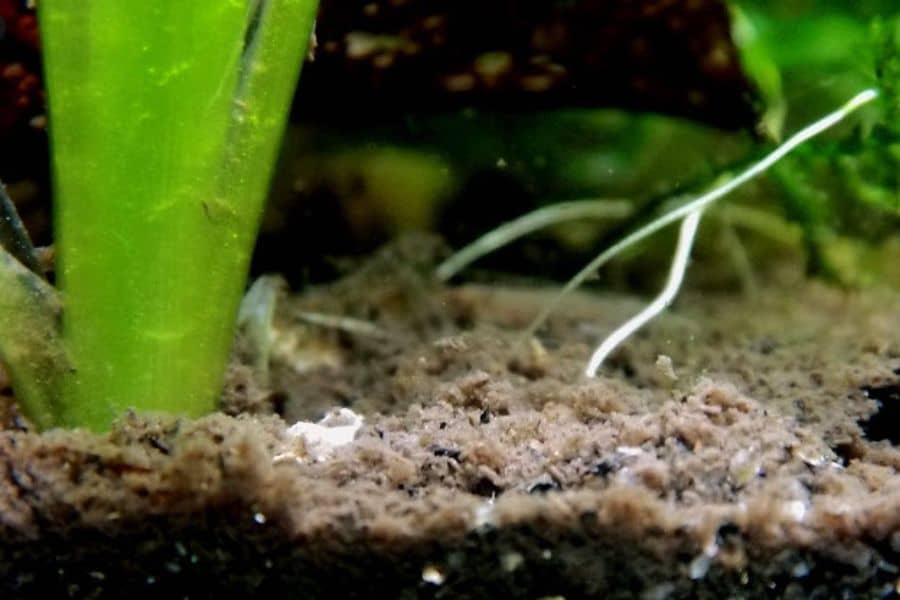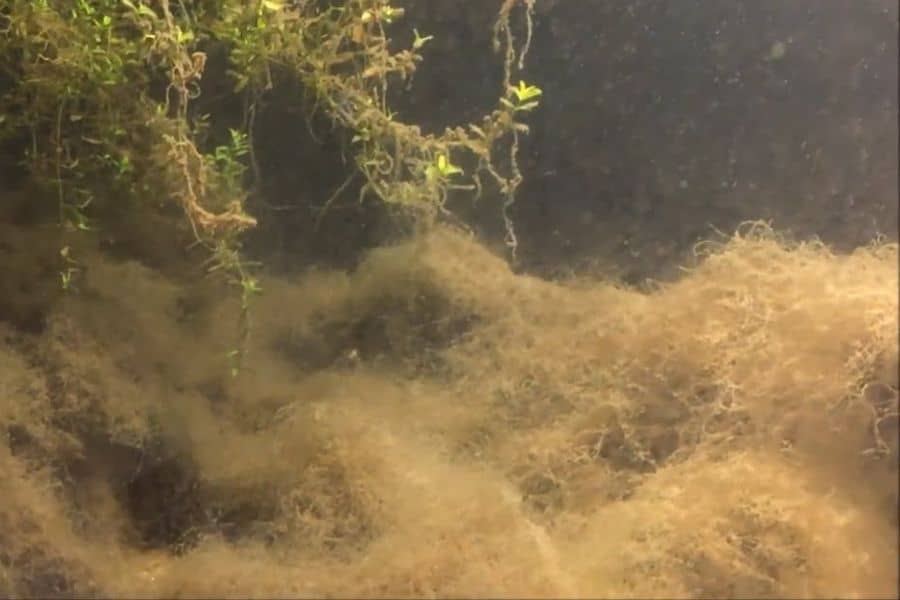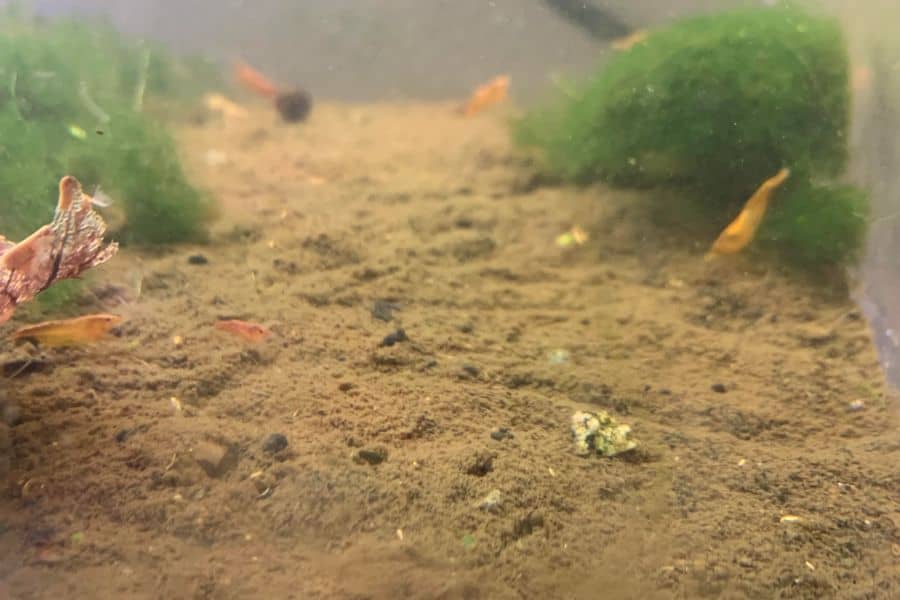Mulm is an old-school term used in the aquarium hobby in the 1950s to 1960s when it was called the “Golden Age” of the hobby. While many elderly hobbyists know what it is, the younger generation isn’t aware of the term. This guide will help explain what mulm is, its benefits and drawbacks, and how to remove it from your aquarium.

What Is Mulm In Aquariums?
Jump To
Mulm is a layer of decomposing organic matter that accumulates on the bottom of an aquarium over time. This build-up consists of fish waste, uneaten food, decaying plants, and other organic debris. Simply called “Detritus” in the modern hobby, it’s a natural part of the aquarium cycle and plays an important role in the ecosystem’s overall health.
Some may describe mulm as “debris” in the aquarium, but this term is quite vague and can refer to anything from fish waste to uneaten food. Mulm is the catch-all expression of all the organic materials that accumulate on the aquarium substrate over time. While mulm is a natural part of the aquarium cycle, that doesn’t mean it’s aesthetically pleasing. Aquarists often want to remove this build-up for the sake of appearance, but there are some trade-offs to consider before doing a big clean-up.
What Does Mulm Look Like In An Aquarium?
Mulm is a black, slimy, and smelly layer of decaying organic matter that covers the bottom of an aquarium. It can vary in thickness, but a layer of mulm is typically 1-2 inches (2.5-5 cm) deep. While mulm may not look pleasant, it’s actually a sign of a healthy aquarium. This build-up is evidence that the ecosystem is cycling properly and breaking down organic waste.
Benefits And Drawbacks Of Mulm In Aquariums
Mulm has both benefits and drawbacks in the aquarium. On the plus side, mulm:
- Helps create a more stable environment
- Adds beneficial bacteria
- Releases nutrients for plants
- Increases plant growth
- Help grow infusoria
On the negative side, mulm:
- Can add to ammonia and nitrate levels
- Can cause problems with filtration
- Reduces oxygen levels
- Prevent plants from getting light
- Increases risk of disease
- Aesthetically unpleasing
Let’s discuss further one by one.

Benefits of Mulm in Aquariums
Helps create a more stable environment
Believe it or not, mulm is a natural way to help stabilize the aquarium environment. As mulm decomposes, it releases ammonia. This process is called the Nitrogen Cycle and is essential to the health of the aquarium ecosystem. The ammonia is then turned into nitrite and then nitrate by bacteria in the water. This process helps to create a more stable environment for fish and other aquatic creatures. The bacteria that convert ammonia to nitrate are present in the mulm layer, so it’s important not to remove all of it.
Adds beneficial bacteria
Mulm is home to beneficial bacteria that help to break down organic waste. These bacteria are essential to the Nitrogen Cycle and help to keep ammonia and nitrite levels low. The bacteria in mulm also help to prevent disease by competing with harmful bacteria for space and food.
Releases nutrients for plants
Mulm not only contains beneficial bacteria but also releases nutrients that are essential for plant growth. These nutrients include nitrogen, phosphorus, and potassium. While these nutrients are also present in fish waste and uneaten food, mulm is a more concentrated source of them. This makes it an important part of the aquarium cycle for planted tanks.
Increases plant growth
The release of nutrients from mulm not only benefits existing plants but also helps to promote new growth. This is because mulm provides a constant source of nutrients that plants can access.
Help grow infusoria
Mulm not only helps to increase plant growth, but it can also help to grow infusoria. Infusoria are tiny creatures that are an important food source for fry and other small fish. Mulm works as a breeding ground for these creatures, providing them with food and shelter.
Drawbacks of Mulm in Aquariums
While mulm has many benefits, there are also some drawbacks to consider.
Can add to ammonia and nitrate levels
One of the main drawbacks of mulm is that it can contribute to ammonia and nitrate levels. As mulm decomposes, it releases ammonia into the water. This can lead to spikes in ammonia levels, which can be harmful to fish. Mulm can also add to nitrate levels if it’s not broken down properly. This is because mulm contains high levels of nitrogen, which is converted to nitrate by bacteria. However, this problem only arises when the aquarium is not cycled properly, or the mulm layer is too thick.
Can cause problems with filtration
Mulm can also cause problems with filtration. This is because mulm can clog filters and reduce their efficiency. If mulm builds up in the filter, it can cause a decrease in water flow and an increase in ammonia levels. To avoid this, make sure to clean the filter regularly and make sure that the mulm layer is not too thick.
Reduces oxygen levels
Another drawback of mulm is that it can reduce oxygen levels in the water. This is because mulm decomposes and uses up oxygen in the process. The amount of oxygen that mulm uses depends on the amount of mulm present and the amount of oxygen in the water. If there’s not enough oxygen in the water, fish and other aquatic creatures can suffocate.
Prevent plants from getting light
Mulm can also prevent plants from getting the light they need. This is because mulm can block sunlight, stunting plant growth. Mulm usually builds up in and on the aquarium substrate but can also build up on the leaves and stems of plants. These mulm build-ups can block out the leaves from getting the necessary light. To prevent this, make sure to keep the mulm layer thin and remove any build-ups that do occur on the plants.
Increases risk of disease
Mulm can also increase the risk of disease. This is because mulm can provide a place for bacteria and parasites to hide. While these bacteria are beneficial most of the time, some disease-causing bacteria can also hide in mulm. Mulm can also contain high ammonia levels, harming fish and other aquatic creatures. These harmful nutrients, bacteria, and parasites can contribute to the spread of disease in an aquarium.
Aesthetically unpleasing
While mulm can be beneficial to an aquarium, it’s not the most aesthetically pleasing thing to look at. Mulm is usually dark in color and can make an aquarium look dirty. Mulm can also build up on the aquarium’s glass, making it difficult to see into the tank. This can be a problem for aquariums that are set up for display purposes.

What Eats Mulm In The Aquarium?
Some may tell you that some fish, shrimp, and snails will eat mulm in aquariums. But the dirty truth is, no aquarium fish except detrivore creatures like infusoria will actually eat mulm. In fact, most aquarium fish will avoid eating mulm at all costs because they simply do not like the taste of it. The same goes for shrimps and snails.
True, some filtering fish like corydoras, guppies, and plecos will explore mulm with their mouths. But what they actually do is find something to eat like algae, leftover fish food, or detrivore creatures living in the mulm. Shrimps and snails also do the same. The only exception to the rule is very small fry and baby fish. Baby fish are still too small and inexperienced to know that mulm is not food. So they will actually eat mulm. But as they grow older and become more experienced, they will quickly learn that mulm is not food and will stop eating it.
How To Get Rid Of Mulm?
The best way to get rid of mulm in your aquarium is to do a water change. Water changes will remove mulm and all the harmful things that come with it. You should do a water change every week or two to control the mulm level in your aquarium. Another way to get rid of mulm is to vacuum it out with a gravel vacuum. Gravel vacuums are designed to remove debris and mulm from the gravel in your aquarium.
You can use a gravel vacuum to remove mulm from your aquarium’s substrate, plants, and glass. Gravel vacuums can be a bit tricky to use (especially the electrical ones), so it’s important to read the instructions that come with them before using them. Mulm can also be removed with a sponge filter. Sponge filters are designed to remove debris and mulm from aquariums. Sponge filters work by trapping mulm and other debris in the sponge. The mulm and debris are then removed when the sponge is cleaned.
But, Do We Have to Remove Mulm?
The truth is that if you have a well-cycled aquarium with some live plants, you don’t have to remove mulm. This is because the mulm bacteria will help convert ammonia into nitrites and nitrates. The plants can then use nitrates as fertilizer. This process is known as the nitrification cycle, and it’s a very important part of having a healthy aquarium. Some aquarists actually add mulm to their aquariums on purpose. This is because the mulm bacteria can help start the nitrification cycle in a new aquarium.
If you have a new aquarium, you can add mulm to it by taking some gravel from an established aquarium and adding it to your new tank. You can also add mulm to a new aquarium by taking some water from an established aquarium and adding it to your new tank. The mulm bacteria will then start to nitrify the ammonia in your new aquarium and establish the nitrification cycle. Mulm can also be added to an established aquarium to help boost the population of nitrifying bacteria. However, most aquarists prefer to remove mulm from their aquariums because it simply does make the aquarium unsightly.
Can We Stop Mulm Build-Up?
Actually, you can not stop mulm buildup if you have fish and plants. This is because the fish waste and dead plant matter will decompose and form mulm. The only way to stop mulm build-up is to remove the fish and plants from your aquarium. Well, if you do that, your aquarium won’t be an aquarium anymore, will it? So, the answer is no. You can not stop mulm build-up in your aquarium.
But, you can keep the mulm level under control by doing regular water changes and vacuuming the mulm out of your aquarium. Further, controlling some simple things like stopping overfeeding your fish and trimming your plants can also help control the mulm level in your aquarium. Overfeeding your fish will create more fish waste, decomposing and forming mulm. So, it’s important only to feed your fish as much as they can eat in a few minutes.
Trimming your plants will also help control the mulm level in your aquarium. This is because dead plant matter will decompose and form mulm. So, removing any dead or dying leaves from your plants is essential to control mulm build-up.
Conclusion
Mulm is the accumulation of fish waste, dead plant matter, and other debris in your aquarium. Mulm can be removed with a water change, gravel vacuum, or sponge filter. You can not stop mulm build-up, but you can keep it under control with regular maintenance. Overfeeding your fish and trimming your plants can also help control the mulm level in your aquarium. However, if you have a well-established aquarium and do not care about the aesthetic but the health of your fish, you may not need to remove the mulm as it can be beneficial for your fish.
Related question
Do shrimp eat mulm?
No, shrimp do not eat mulm. Shrimp are filter feeders that feed on microscopic organisms in the water column. They may accidentally ingest some mulm while filter-feeding, but they do not eat it on purpose.
What is the difference between mulm and algae?
Mulm is the accumulation of fish waste, dead plant matter, and other debris in your aquarium. Algae is a plant (protists) that grows in water. Mulm can contain algae and help grow algae, but mulm is not algae.
Yeast In Reef Tank | The Ultimate Guide For Beginners |
